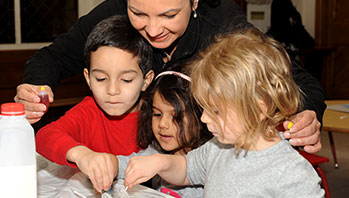- butter containers
- packaging tape
- small balls (golf, ping pong, pompoms, rope balls, etc.)
- strips of white paper to line ramps
- tempera paints
- various materials for making ramps with flat surfaces
- ramp
- roll
- slide
- track
MA Standards:
Language/L.PK.MA.6: Use words and phrases acquired through conversations, listening to books read aloud, activities, and play.
MA Draft STE Standards:
Physical Sciences/Motion and Stability; Forces and Interaction/PS2.A: Plan and carry out investigations of the behaviors of moving things.
Physical Sciences/Motion and Stability; Forces and Interaction /PS2.B: Using evidence, discuss ideas about what is making something move the way it does and how some movements can be controlled. [Cause and Effect, Stability and Change]
Head Start Outcomes:
Logic and Reasoning/Reasoning and Problem Solving: Classifies, compares, and contrasts objects, events, and experiences.
Approaches to Learning/Initiative and Curiosity Demonstrates flexibility, imagination, and inventiveness in approaching tasks and activities.
PreK Learning Guidelines:
English Language Arts/Language 2: Participate actively in discussions, listen to the ideas of others, and ask and answer relevant questions.
Science and Technology/Inquiry Skills 3: Identify and use simple tools appropriately to extend observations.
Small Group: Ramp Track Paintings

© Commonwealth of Massachusetts, Department of Early Education and Care (Jennifer Waddell photographer). All rights reserved.
STEM Key Concepts: A ramp, or inclined plane, is a surface with one end higher than the other; An object placed on an inclined plane will roll, slide, or stay put; The shape of an object affects whether it will roll or slide or stay put
ELA Focus Skills: Compare and Contrast, Speaking and Listening, Vocabulary
Educator Prep: Cover a large area with newspaper or chart paper. Cut long strips of white paper to line the ramps (you may need to tape down the strips). Prepare containers with about an inch of tempera paint. Set up two or three ramps of different heights and tape them to the floor so they don’t move around. Set a large bucket of water off to the side of the area.
Draw attention to the ramps lined with white paper. Tell children that they are going to make ramp paintings. Explain to them that they will take turns sending balls down the ramps to create colored tracks.
- Demonstrate for children how to roll a ball in a container of paint.
- Then carefully place the ball on the track, send it down the ramp, and watch the ramp painting come to life!
- Explain to children that they need to dip the ball in the bucket of water to clean it off for the next child. Encourage children to explore making paint tracks with balls of different sizes and textures.
Discuss how each ball rolls down the track and the different marks each one makes. Ask children to tell why they think the balls make the tracks they do. Create a “Roll and Slide Museum” by hanging children’s paintings from the ceiling and around the room.
